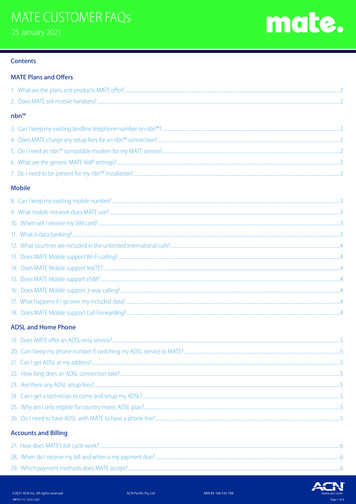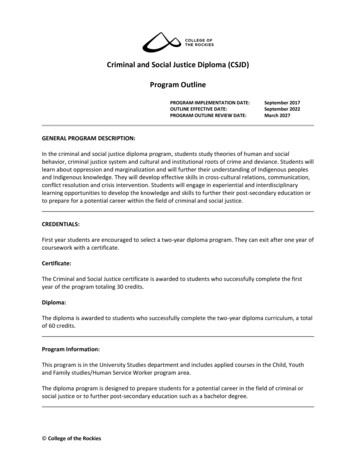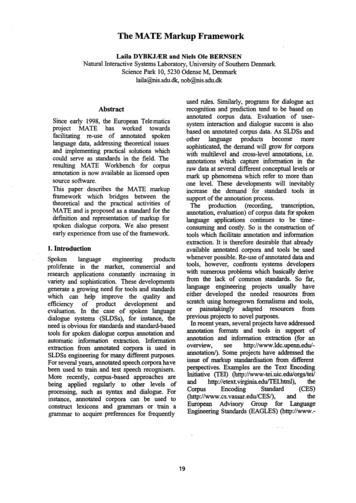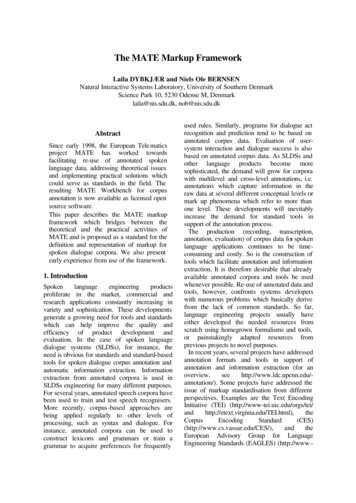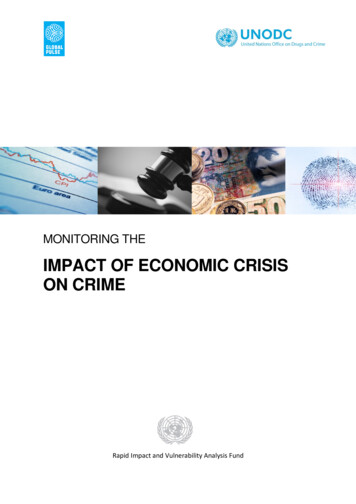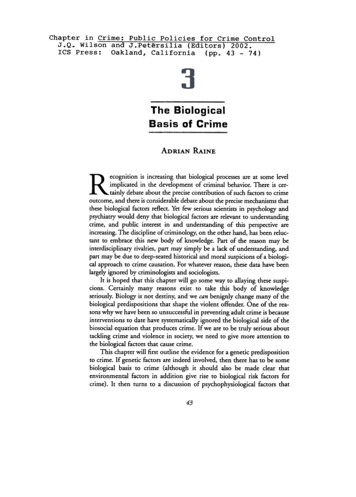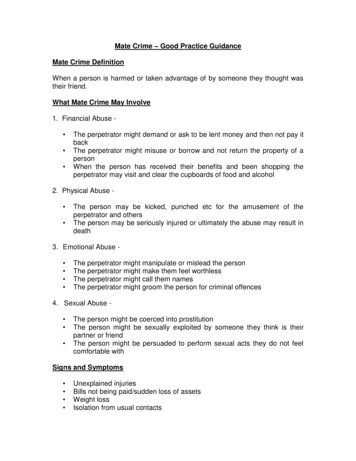
Transcription
Mate Crime – Good Practice GuidanceMate Crime DefinitionWhen a person is harmed or taken advantage of by someone they thought wastheir friend.What Mate Crime May Involve1. Financial Abuse The perpetrator might demand or ask to be lent money and then not pay itbackThe perpetrator might misuse or borrow and not return the property of apersonWhen the person has received their benefits and been shopping theperpetrator may visit and clear the cupboards of food and alcohol2. Physical Abuse The person may be kicked, punched etc for the amusement of theperpetrator and othersThe person may be seriously injured or ultimately the abuse may result indeath3. Emotional Abuse The perpetrator might manipulate or mislead the personThe perpetrator might make them feel worthlessThe perpetrator might call them namesThe perpetrator might groom the person for criminal offences4. Sexual Abuse The person might be coerced into prostitutionThe person might be sexually exploited by someone they think is theirpartner or friendThe person might be persuaded to perform sexual acts they do not feelcomfortable withSigns and Symptoms Unexplained injuriesBills not being paid/sudden loss of assetsWeight lossIsolation from usual contacts
Withdrawal from servicesChanges in behaviour or moodAn overly critical or disrespectful friendVulnerable adults often do not recognise that they have been the subject of matecrime.The focus of enabling safety needs to be on encouraging anunderstanding for the individual of their right to make choices, but also their rightto remain free from abuse.Action to Take if Mate Crime is Identified Talk to the service user. What are their views and concerns?Appropriate action should be taken to ensure the safety of the victimIf a crime is suspected, Police must be informed regardless of whether thevictim is in agreementConsider whether the Safeguarding process should be startedInformation from other agencies should be soughtIf the victim receives Direct Payments and the money is being abused,seek advice from the Direct Payments Team e.g. would a ‘managedaccount’ be more suitableInvestigate if the victim needs assistance with cancelling bank cards etcOffer assessments/support as appropriatePreventative Action Consideration should be given as to whether the safeguarding processshould be started when suspicions are raised rather than waiting for hardevidencePeople need to be enabled to feel they are part of the communityMate crime statistics need reporting (appropriate completion of AISsafeguarding module)More training needs to be given, including use of MCA, within allprofessional agenciesRaising community awareness of Mate CrimeEstablishing Mate Crime Champions within a variety of agencies who willlink with other professionals, service users, carersPosters/leaflets to be given to those participating in the Safer PlacesSchemePartnership WorkingConsider involving other agencies – Hampshire PoliceHCC Accredited Community Safety OfficersHampshire Fire and Rescue Community Safety Officers
Housing OfficersCommunity Health ServicesIdeas for Raising Awareness Talk to groups of people who live in sheltered housing, extra care housing,supported livingShow Mate Crime DVDHand out informationTalk to voluntary groups, social clubs, charitiesShare case examples with colleaguesDistribution of posters e.g. care homes, offices, GP surgeries, SaferPlacesResearch has highlighted common factors in Mate Crime and Hate Crime Disabled people may be reluctant to report the crimes as they fear theywill not be believed.There have usually been previous incidents which become regulartargeting.Incidents are likely to escalate in severity and frequency – so servicesshould aim to intervene at an early stage.Perpetrators are often ‘friends’, carers, acquaintances or neighbours andvictims may be reluctant to sever the relationship.There may be multiple perpetrators who encourage the main offender.Perpetrators might make false accusations that the victim is a paedophileor ‘grass’.Cruelty, degrading treatment and humiliation is often related to the person’sdisability.Summary of Good Practice Prevent potential victims being the subject of mate crimeIdentify when a vulnerable adult is the victim of mate crimeTake action when concerns are raisedMinimise the escalation of the mate crime through a protection planIdentify the individual(s) responsible for the crimeRaise awareness amongst the public and professionals of mate crimeAdditionally, promote the ethos of – Enhancing social networks for vulnerable adults
Developing positive friendships and relationships within the community sothat vulnerable people do not feel so isolated and therefore are less likelyto be a victim of mate crime.Raising self esteem and increased self confidence through advice andguidance so that vulnerable people feel more able to protect themselvesfrom abuse.And further Develop Professional Practice by – Accurate recording of mate crime occurrences.Inter-agency sharing of good practice and learning outcomes.Assisting victims to indentify for themselves when they have been thesubject of mate crime and empowering them to take appropriate actionwherever possible.Taking action on behalf of those adults unable to protect themselves.Local case studies1) Concern Raised - Two male perpetrators from the Portsmouth areabefriended a vulnerable adult with learning difficulties. The perpetrators were wellknown to the police for violence and theft. In this case they were financiallyabusing the vulnerable adult who gave them money when asked. He felt he hadno choice but to do this.Fortunately he told his care worker what washappening and the details were passed to the police.Response from Services - The police then made a referral to the AccreditedCommunity Safety Officers with a request for them to visit the victim. With theagreement of the victim, weekly well being visits were established. This resultedin the perpetrators withdrawing once they became aware that Police and ACSO’swere involved. The vulnerable male was pleased that people in the communitycared and he could share his problems with people he could trust.2) Concern Raised - A group of vulnerable adults meet on a weekly basis in aCommunity Centre. Some of these people live in residential care settings andsome of them live on their own.The manager of this group requested apresentation from the Accredited Community Safety Officers about Mate Crimeas members of the group had experienced Mate Crime and doorstep crimeResponse from Services - The ACSO’s visited the Group and gave a talk wasaimed at raising awareness of Mate Crime within the group. The service usersare now familiar with the ACSO’s through regular visits and trust them resultingin the fact that they will now share information/concerns.3) Concern Raised - It was discovered that unexplained withdrawals had beentaken from a service user’s bank account and concerns were raised that she was
allegedly being financially abused by a member of her family. The concerns werehighlighted through a safeguarding meeting.Response by Services - The care manager was asked to approach the bank togain further details on how the funds were being taken from the individual’s bankaccount and to explore safeguards that could be put in place. The bank at thispoint advised the care manager that they could not share any personal detailswithout the service user being present. However, they did strongly recommendthat the care manager came back with the service user as soon as possible(implying there was reasons to be concerned). The care manager returned withthe service user and was able to talk to the bank manager. Due to the serviceuser having a hearing impairment and the need for loud speech to be used, thecare manager requested a private room and this was provided. This allowed theservice user to be fully involved in the consultation, to give permission forinformation to be shared and for safeguards to be put in place. As the serviceuser did not use internet banking or her bank card to make payments, thesefacilities were stopped on her account. The bank also advised that they couldwork with the police to trace whose computer was being used and the PPUvisited the service user with the care manager to discuss this. However, theservice user declined to proceed with further police involvement. Nevertheless,the service user also gave permission for the care manager to contact the bankmanager at regular intervals to check there had not been any unusual activity onthe account and the bank manager also gave her direct line number to aid in this.4) Concern raised - A service user with a learning and physical disability wasbefriended by a group of young people. They borrowed money off her andencouraged her to claim to her insurance company that her lap top was broken,whereas in fact they had sold it.Response from Services - With assistance, the service user was able todistance herself from this group of young people and join alternative socialgroups. However, although she recognises that she was taken advantage of,she still misses this group of young people, saying that they made her feel‘attractive’ and ‘normal’.5) Concern Raised - A physically disabled service user entered into an on-linerelationship with a female prisoner in another part of the country, regularlysending her sums of money. They arranged that he would go to visit her over abank holiday weekend. However, prison staff were given intelligence that in factthis prisoner had passed on details of where the service user would be stayingand his home address. It was suspected that he might be the target of robberyand/or burglary.Response from Services - A social worker visited the service user togetherwith a Police Officer and explained the situation. The service user decided to stillgo ahead with the planned visit, but agreed for safeguards to be put in place. It
was arranged for an agreed limit to be placed on the amount of money that couldbe withdrawn from a cashpoint in any one day, he would use taxis whentransferring between the station/ hotel and the hotel/prison rather than usingpublic transport. The local Police Beat Officer also kept an eye on the propertywhilst the service user was away. The visit went ahead successfully and theservice user continues, as an informed decision, to send the female prisonerregular sums of money.Mate Crime - Learning from Serious Case ReviewsThe murder of Gemma Hayter (2010) Gemma had a learning disability, but had no formal diagnosis, sospecialist health and social care services were not always available to her.Gemma herself was reluctant to access services. There were questionsabout her capacity but it was felt that she was able to decide on what helpshe wanted.Gemma had suffered mate crime regularly over some time. She wasfound dead on a disused railway embankment. She was 27. She had beenforced to drink urine from a beer can, beaten with a mop and strippedbefore being left for dead by people she regarded as her ‘friends’.The Serious Case Review found no evidence that her death could havebeen predicted or prevented, however opportunities were missed to get aclearer picture of her situation and to have provided support that mighthave made her less likely to fall into the company of those people.No single agency had the whole picture. None of the agencies involvedknew the details of her relationship with the five killers. There had been alack of information sharing.Gemma’s background As a child Gemma was diagnosed with a learning disability, with differingreports about severity, and as being on the autistic spectrum. She went toa special school for her secondary education.At transition she was assessed as meeting eligibility for access to socialcare services (FACS), however after the age of 18 she was subsequentlytested and found not to have a learning disability or Autistic SpectrumDisorder, she was subsequently deemed ineligible for secondary healthand social care services on the grounds that she did not have a diagnosedlearning disability.She had difficulty making friends and was at risk of being exploited. In2004 age 21 she lived in supported housing.
Her tenancy broke down in 2006, and she was felt to be aggressive andun co-operative. She was referred to mental health services and wasassessed in 2007/2008 as having a Conduct Disorder. Her CPN tried torefer her to Adults Services unsuccessfully, the CPN closed the case.Her lifestyle was becoming chaotic and she had involvements with thepolice.A police safeguarding referral to Adults Services resulted in the policebeing advised to contact the mental health services. However nosafeguarding meeting was held and there was no on-going input from themental health services.Gemma moved to another tenancy (Aug 2008) and received tenancysupport funded via Supporting People.There was evidence of increasing self neglect, debts, chaotic life style andreluctance to engage with services. She had no job or day servicesopportunities. The ‘friends’ she spent time with were involved in pettycrimes and drug and alcohol abuse.The Perpetrators – two couples and a single man One of the women had known Gemma for 18 months prior to her murderAll perpetrators were between the ages of 17 and 21DN (male) was known to Youth Justice and Probation for violent crimesand anti social behaviour, also known to mental health and subs misuseservices though no diagnosed mental illness.CB (female) was violent, bullying and also the victim of domestic abuse,she lived with DN, and had a previous conviction of common assault.JL (female) known to police as a perpetrator and victim of crimeJB (male) partner to JL, involved in drug use, known to police, in breach ofhis court order, not known to be violent.DE (male) had been convicted of 9 offences.Gemma’s murder in August 2010 7 August – Gemma was drinking with the 5 perpetrators and caused asituation which the 5 felt had spoilt the evening.8 August – the group drinking and smoking cannabis, Gemma joined themin the early evening and was subject to serious and prolonged assaultsover a period of 4 hours including violence leading to a broken nose andbeing forced to drink urine from a can – the perpetrators link theirbehaviour to the allegation (unsubstantiated) that Gemma owed money toCB .9 August – in the early hours the group walked her to a disused railwayline, Gemma was physically assaulted, stabbed and beaten to death.
Key findings “No evidence that Gemma’s murder could have been predicted orprevented but if she had received and accepted better support, she mayhave been less likely to fall into the company of people who presented herwith serious risks”.The statutory agencies were not aware of Gemma’s involvement with the5 perpetrators or that they were a risk to vulnerable adults.There was clear evidence that Gemma was vulnerable to the risk of abuseand vulnerable to mate crime.No single agency had a full picture of what was happening.There were missed opportunities for initiating safeguarding procedures orother interventions.Lessons learned Right to assessment - Learning disability services should not have saidGemma was ineligible for services based solely on the fact that she didnot have a diagnosis of LD – there should have been reference to FACSrisk/needs led assessment. In Hampshire we have a Policy related toVulnerable Adults (policy number and link) which confirms our statutoryobligation to assess the needs of any adult in need of assessment,irrespective of whether they have a diagnosis or fall clearly into a specificcare group.Managing situations where service users dis-engage - there was noevidence of risk assessments being undertaken to inform the decision toclose, instead there was over reliance on client dis-engagement/choice asreason for closure.Practitioners need more guidance on working with ‘difficult to engage’service users – using assertive outreach approaches.It was assumed that Gemma had capacity to make key decisions, but noassessment of mental capacity undertaken. Professionals focussed onGemma’s ‘right to choose’ over their common law ‘duty of care’.Low level safeguarding alerts did not always trigger full investigations –there is a need to recognise risk indicated by patterns of low levelconcerns.The murder of Stephen Hoskins (2006)On 6 July 2006 his body was found at the base of the St. Austell railway viaduct.In addition to his bearing catastrophic injuries associated with falling 30 metres, apost-mortem examination confirmed that Steven had taken paracetamol tablets,had been drinking alcohol and had sustained recent injuries from cigarette burns.Further, he had neck bruises from having been hauled around his home by hisown pet’s dog-lead and the backs of his hands bore the marks of foot-prints. On
the night of his murder, Steven had been found ‘guilty’ by the three people whomurdered him of being ‘a paedophile.’ While this claim was without foundation itwas determined by the perpetrators as the reason why Steven should die.Steven Hoskin’s learning disability became apparent in his early childhood. At 12years of age he left a local primary school and became a weekly boarder at aspecial school, returning to his mother at weekends. Steven did not read. Afterleaving school at 16, Steven was unable to secure employment and wasadmitted as an inpatient to an NHS ‘Assessment and Treatment’ unit for peoplewith learning disabilities and mental health problems. Steven’s life revolvedaround a small number of key relationships – his mother, the owner of the localfarm and people at a coal merchant’s where he helped from time to time, and,importantly, his dog Sue. Over time Steven’s relationship with his motherdeteriorated and ultimately became characterised by conflict and violentoutbursts. In September 2003, Steven was charged and convicted with commonassault and he was subject to a Probation Order.Steven was assessed as having, ‘substantial need’ according to the Fair Accessto Care Criteria. It was planned that Steven should have weekly visits. Thissupport was discontinued by Steven in August 2005. Steven’s health needssignificantly increased when he discontinued contact with Adult Social Care andDarren and others were spending increasing periods of time in Steven’s bed-sit.He was seen a number of times by his GP and at A&E. In April 2006 Stevenvisited a Minor Injury Unit with chest pains and stated that he had beenassaulted. This was not reported to the police. Steven also made increasingnumber of calls to the police during this period. His alcohol intake increased.The Perpetrators – DS (male) aged 30 years old, SB (girlfriend to DS) aged 17,and MP (male) aged 21. DS was a ‘run-away’ child who went on to live in anunknown number of care homes and secure services. He was sent to prison forarson and later was convicted of a street robbery. His misuse of alcohol andamphetamines and being ‘on the move’ came to characterise his adult life.Between 1998 and 2006 DS had five children with three teenage partners, all ofwhom were vulnerable. These were volatile relationships. At a Review ChildProtection Conference it was stated that DS had a borderline personalitydisorder. He had a history of overdoses, arrests and detentions under the MentalHealth Act.Lessons learnedPoor inter agency communicationNot all staff receiving and collecting information made it availabletheir organisations or, as importantly, to partner organisations.senders need to know that their information has been receivedconfirm to what use it has been put. It is not enough to sendto others inInformationand shouldor ‘leave’ a
message. This leads to the error of assuming that information that has beenpassed on or shared will be ‘known’ by recipients.Support to people with a learning disability who are socially isolatedA diagnosis of learning disability should imply support needs throughout the lifecourse, most particularly for those who are without protective social networks,day to day routines and/ or the geographical proximity of families who are ableand willing to assist. Steven wanted friends. He did not see that the friendship hehad so prized was starkly exploitative, devoid of reciprocity and instrumental inobstructing his relationships with those who would have safeguarded him.Dis-engagement with services- It is essential that health and social care services review the implications ofacceding to people’s ‘choice’ if the latter is not to be construed as abandonment(e.g. Flynn, Keywood and Fovargue 2003).- Steven’s ‘choice’ to terminate contact with Adult Social Care was notinvestigated or explored with him, or other key agencies involved in his care,even though such choices may compound a person’s vulnerability; may be madeon the basis of inadequate or inappropriate information; or result from theexercise of inappropriate coercion from third parties.- The process of determining that people are making ‘choices’ is frequentlyneither specific nor very explicitly discussed; sound assessment of mentalcapacity is required – to understand whether the choice to dis-engage was aninformed one.Known risk factors Patterns of low level concerns should be responded to beforebehaviours escalate. People living alone may be more vulnerable, particularly when theadult is associating with peers where the subculture has normaliseddrug misuse, crime, violence and mate crime.
And further Develop Professional Practice by - Accurate recording of mate crime occurrences. Inter-agency sharing of good practice and learning outcomes. Assisting victims to indentify for themselves when they have been the subject of mate crime and empowering them to take appropriate action wherever possible.
